Temporal and Spatial Diversity of Renewable Groundwater Resources in the River Valley
Abstract
1. Introduction
2. Background to the Study Site
2.1. Topography and Geomorphology
2.2. Hydrogeological Conditions
3. Research Methods
3.1. Observation Period, Research Variants
- variant 1-steady state level, defined as the mean annual hydrodynamic state for the 1999–2013;
- variant 2-the highest groundwater levels in the period 1999–2013;
- variant 3-the lowest groundwater levels in the period 1999–2013.
3.2. Model Studies
4. Results
4.1. Groundwater Depth (GD)
4.2. Renewable Groundwater Resources
4.3. Groundwater Footprint
5. Discussion
6. Conclusions
- The calculations of renewable resources were done for variants that refer to average and extreme values of groundwater level in relation to possible climate changes understood as time-variable precipitation. The quantitative assessment of renewable groundwater resources of a shallow aquifer was made based on model tests in 3 variants: variant 1-steady state level, defined as the average annual hydrodynamic state for the years 1999–2013, variant 2, the highest groundwater levels in the period 1999–2013, and variant 3, the lowest groundwater levels in this period.
- For the average groundwater level, the volume of renewable resources was 0.65 L/s km2 for the area where the groundwater depth is 2.15 m. The amount of resources is spatially variable, both in relation to the identified geomorphological units and within them. The highest values appear in the uppermost Otwock Terrace (I) and are 1.16 L/s km2, where the groundwater depth is 3.22 m, while the lowest values are 0.05 L/s km2 in the Falenica terrace (II), where the average depth is 1.41 m.
- The groundwater renewability is directly related to the depth to groundwater table. In a period of the highest water levels, virtually all geomorphological forms in the valley showed a prevalence of evapotranspiration over recharge. In a drought period, the value of renewable resources in all geomorphological units was positive. The diversity in the volume of renewable resources is associated also with the occurrence of GDEs in the valley. Any resource calculations should be based on geomorphological, hydrogeological and environmental analyses, defined as morphohydrogeological studies.
- During the periods of hydrogeological drought (variant 2) and flood conditions (variant 3), the renewability of groundwater resources was much lower than in the period 1999–2013. It was 88% lower in the period of the highest levels and 30% less than the average during hydrogeological drought, when reduced precipitation did not influence the reduction in the amount of renewable resources as much as it did during the highest levels. Therefore, intensification of evaporation losses should be considered as the main reason for low (or lack of) renewability in the annual cycle.
- The groundwater footprint and the footprint index were defined as a quantitative assessment of the use of groundwater in climate change conditions. For the Vistula valley in the study area, the groundwater footprint GF was 80.38 km2. The water footprint index GF/A, determining the pressure on groundwater, was 0.14, classifying the aquifer as not threatened by excessive abstraction. The groundwater footprint in various calculations ranged from 29.50 to 315.91 km2. Taking into account the evaporation, the groundwater footprint in various calculations ranged from 674.47 to 1722.30 km2. For areas of shallow groundwater table in a hydrogeological valley unit, the effect of evaporation should be considered as a key potential factor causing an increase in the groundwater footprint. Studies have shown that evaporation and associated functioning of GD significantly increase groundwater pressure.
Author Contributions
Funding
Conflicts of Interest
References
- Chambel, A. The role of groundwater in the management of water resources in the World. Hydrological Sciences and Water Security: Past, Present and Future (Proceedings of the 11th Kovacs Colloquium, Paris, France, June 2014). IAHS Publ. 2014, 366, 107–108. [Google Scholar] [CrossRef][Green Version]
- Scanlon, B.R.; Healy, R.W.; Cook, P.G. Choosing appropriate techniques for quantifying groundwater recharge. Hydrogeol. J. 2002, 10, 18–39. [Google Scholar] [CrossRef]
- Herbich, P.; Kapuściński, J.; Nowicki, K.; Rodzoch, A. Metodyka określania zasobów dyspozycyjnych wód podziemnych w obszarach bilansowych z uwzględnieniem potrzeb jednolitych bilansów wodnogospodarczych. In Poradnik Metodyczny; HYDROEKO.: Warszawa, Poland, 2013; p. 270. [Google Scholar]
- Halford, K.J.; Mayer, G.C. Problems Associated with Estimating Groundwater Discharge and Recharge from Stream Discharge Records. Ground Water 2000, 38, 331–342. [Google Scholar] [CrossRef]
- Otto, R. Estimating groundwater recharge rates in the southeastern Holstein region, northern Germany. Hydrogeol. J. 2001, 9, 498–511. [Google Scholar] [CrossRef]
- Krogulec, E. Vulnerability Assessment of Groundwater Pollution in the River Valley on the Basis of Hydrodynamic Evidence; Warsaw University Print: Warsaw, Poland, 2004; p. 124. (In Polish) [Google Scholar]
- Sanz, E. Springs in Spain: Classification according to their flows and lithologies and their hydraulic contributions. Ground Water 1996, 34, 1033–1041. [Google Scholar]
- Gleeson, T.; Wada, Y.; Bierkens, M.F.P.; van Beek, L.P.H. Water balance of global aquifers revealed by groundwater footprint. Nature 2012, 488, 197–200. [Google Scholar] [CrossRef] [PubMed]
- De Vries, J.J.; Simmers, I. Groundwater recharge: An overview of processes and challenges. Hydrogeol. J. 2012, 10, 5–17. [Google Scholar] [CrossRef]
- Scanlon, B.R.; Reedy, R.C.; Gates, J.B. Effects of irrigated agroecosystems: 1. Quantity of soil water and groundwater in the southern High Plains, Texas. Water Resour. Res. 2010, 46, W09537. [Google Scholar] [CrossRef]
- Assouline, S.; Tyler, S.W.; Selker, J.S.; Lunati, I.; Higgins, C.W.; Parlange, M.B. Evaporation from a shallow water table: Diurnal dynamics of water and heat at the surface of drying sand. Water Resour. Res. 2013, 49, 4022–4034. [Google Scholar] [CrossRef]
- Sanford, W.E. Recharge and groundwater models: An overview. Hydrogeol. J. 2002, 10, 110–120. [Google Scholar] [CrossRef]
- Yeh, H.F.; Lee, C.H.; Chen, J.F. Estimation of groundwater recharge using water balance model. Water Resour. 2007, 34, 153. [Google Scholar] [CrossRef]
- Crosbie, R.S.; Scanlon, B.R.; Mpelasoka, F.S.; Reedy, R.C.; Gates, J.B.; Zhang, L. Potential climate change effects on groundwater recharge in the High Plains Aquifer, USA. Water Resour. Res. 2013, 49, 3936–3951. [Google Scholar] [CrossRef]
- Meixner, T.; Manning, A.H.; Stonestrom, D.A.; Allen, D.M.; Ajami, H.; Blasch, K.W.; Walvoord, M.A. Implications of projected climate change for groundwater recharge in the western United States. J. Hydrol. 2016, 534, 124–138. [Google Scholar] [CrossRef]
- Pazdro, Z.; Kozerski, B. Hydrogeologia Ogólna; Wydawnictwo Geologiczne: Warszawa, Poland, 1990; p. 624. [Google Scholar]
- Daly, E.P. Groundwater resources of the Nore River basin; Geol. Report Series RS 94/1 (Groundwater); Geological Survey of Ireland: Dublin, Ireland, 1994; Unpublished internal GSI report. [Google Scholar]
- Acharya, S.; Jawitz, J.W.; Mylavarap, R.S. Analytical expressions for drainable and fillable porosity of phreatic aquifers under vertical fluxes from evapotranspiration and recharge. Water Resour. Res. 2012, 48, W11526. [Google Scholar] [CrossRef]
- Cao, G.; Scanlon, B.R.; Han, D. Impacts of thickening unsaturated zone on groundwater recharge in the North China Plain. J. Hydrol. 2016, 537, 260–270. [Google Scholar] [CrossRef]
- Brito, M.G.; Costa, C.N.; Almeida, J.A.; Vendas, D.; Verdial, P.H. Characterization of maximum infiltration areas using GIS tools. Eng. Geol. 2006, 85, 14–18. [Google Scholar] [CrossRef]
- Pratama, E.; Irawan, D.E.; Susanto, A.; Ardi, R.D.W. Influence of Lithology and Slope Gradient to Infiltration of the Mount Malabar, West Java. IOP Conf. Ser. Earth Environ. Sci. 2016, 29, 012025. [Google Scholar] [CrossRef]
- Huang, H.; Huang, T.; Pang, Z.; Liu, J.; Yin, L.; Edmunds, W.M. Groundwater recharge in an arid grassland as indicated by soil chloride profile and multiple tracers. Hydrogeol. Process. 2017, 31, 1047–1057. [Google Scholar] [CrossRef]
- McMahon, P.B.; Dennehy, K.F.; Bruce, B.W.; Böhlke, J.K.; Michel, R.L.; Gurdak, J.J.; Hurlbut, D.B. Storage and transit time of chemicals in thick unsaturated zones under rangeland and irrigated cropland, High Plains, United States. Water Resour. Res. 2006, 42, W03413. [Google Scholar] [CrossRef]
- Hunt, R.J.; Prudic, D.E.; Walker, J.F.; Anderson, M.P. Importance of unsaturated zone flow for simulating recharge in a humid climate. Groundwater 2008, 46, 551–560. [Google Scholar] [CrossRef]
- Wang, S.; Shao, J.; Song, X.; Zhang, Y.; Huo, Z.; Zhou, X.Y. Application of MODFLOW and geographic information system to groundwater flow simulation in North China Plain, China. Environ. Geol. 2008, 55, 1449–1462. [Google Scholar] [CrossRef]
- Zeng, Y.; Zhao, C.; Li, J.; Lv, G.; Liu, T. Effect of groundwater depth on riparian plant diversity along riverside-desert gradients in the Tarim River. J. Plant. Ecol. 2019, 12, 564–573. [Google Scholar] [CrossRef]
- Ginige, M.P.; Kaksonen, A.H.; Morris, C.; Shackelton, M.; Patterson, B.M. Bacterial community and groundwater quality changes in an anaerobic aquifer during groundwater recharge with aerobic recycled water. FEMS Microbiol. Ecol. 2013, 85, 553–567. [Google Scholar] [CrossRef]
- De Giglio, O.; Barbuti, G.; Trerotoli, P.; Brigida, S.; Calabrese, A.; Di Vittorio, G.; Lovero, G.; Caggiano, G.; Uricchio, V.F.; Montagna, M.T. Microbiological and hydrogeological assessment of groundwater in southern Italy. Environ. Monit. Assess. 2016, 188, 638. [Google Scholar] [CrossRef]
- Barba, C.; Folch, A.; Gaju, N.; Sanchez-Vila, X.; Carrasquilla, M.; Grau-Martínez, A.; Martínez-Alonso, M. Microbial community changes induced by Managed Aquifer Recharge activities: Linking hydrogeological and biological processes. Hydrol. Earth Syst. Sci. 2019, 23, 139–154. [Google Scholar] [CrossRef]
- Sidle, R.C.; Onda, Y. Hydrogeomorphology: Overview of an emerging science. Hydrol. Process. 2004, 18, 597–602. [Google Scholar] [CrossRef]
- Griffiths, J.S.; Abraham, J.K. Factors affecting the use of applied geomorphology maps to communicate with different end-users. J. Maps 2008, 4, 201–210. [Google Scholar] [CrossRef]
- Soman, K. Geology of Kerala; Geological Society of India: Bangalore, India, 2002; p. 32. [Google Scholar]
- Ramaiah, S.N.; Gopalakrishna, G.S.; Srinivasa Vittala, S.; Najeeb, K.M.D. Geomorphological Mapping for Identification of Ground Water Potential Zones in Hard Rock Areas Using Geo-spatial Information—A Case Study in Malur Taluk, Kolar District, Karnataka, India. Nat. Environ. Pollut. Technol. 2012, 11, 369–376. [Google Scholar]
- Rajaveni, S.P.; Brindha, K.; Elango, L. Geological and geomorphological controls on groundwater occurrence in a hard rock region. Appl. Water Sci. 2017, 7, 1377. [Google Scholar] [CrossRef]
- Krogulec, E.; Zabłocki, S.; Zadrozna, D. Variability of Intrinsic Groundwater Vulnerability to Pollution in River Valley due to Groundwater Depth and Recharge Changes. Appl. Sci. 2019, 9, 1133. [Google Scholar] [CrossRef]
- Available online: www.pgi.gov.pl/psh (accessed on 25 June 2020).
- Krogulec, E. Evaluation of infiltration rates within the Vistula River valley, central Poland. Acta Geol. Pol. 2000, 60, 617–628. [Google Scholar]
- Magnuszewski, A. Zautomatyzowany sposób obliczania charakterystyk niżówkowych (Automatized way of low water characteristics estimation). Przegląd Geofiz. 1990, 1–2, 79–83. (In Polish) [Google Scholar]
- Soczyńska, U.; Gutry-Korycka, M.; Pokojska, P.; Mikos, D. Bilans potamologiczny jako metoda oceny zmienności obiegu wody w dorzeczu Łasicy (Kampinoski Park Narodowy). Ecohydrol. Hydrobiol. 2003, 3, 291–309. (In Polish) [Google Scholar]
- Krogulec, E.; Zabłocki, S.; Sawicka, K. Changes in groundwater regime during vegetation period in groundwater dependent ecosystems. Acta Geol. Pol. 2016, 66, 525–540. [Google Scholar] [CrossRef]
- Baraniecka, M.D.; Konecka–Betley, K. Fluvial sediments of the Vistulian and Holocene in the Warsaw Basin. Geograph. Stud. 1987, 4, 151–170. [Google Scholar]
- Morawski, W. Objaśnienia do Szczegółowej mapy geologicznej Polski w skali 1: 50 000. arkusz Warszawa–Zachód (523); Wydawnictwo Geologiczne: Warszawa, Poland, 1980. [Google Scholar]
- Starkel, L. Historia doliny Wisły od ostatniego zlodowacenia do dziś. Polska Akademia Nauk. Instytut Geografii i Przestrzennego Zagospodarowania im. Stanisława Leszczyckiego. Monografie 2001, 2, 263. (In Polish) [Google Scholar]
- Kopczyńska–Żandarska, K. Objaśnienia do Szczegółowej mapy geologicznej Polski w skali 1: 50 000, arkusz Czerwińsk (485); Wydawnictwo Geologiczne: Warszawa, Poland, 1970. [Google Scholar]
- Krogulec, E. Podatność specyficzna i naturalna wód podziemnych na zanieczyszczenia w dolinie rzecznej. Hydrogeologia 2011, 445, 337–343. [Google Scholar]
- Krogulec, E. Intrinsic and specific vulnerability of groundwater in a river valley—Assessment, verification and analysis of uncertainty. J. Earth Sci. Clim. Chang. 2013, 4, 6. [Google Scholar] [CrossRef]
- Krogulec, E. Evaluating the risk of groundwater drought in groundwater-dependent ecosystems in the central part of the Vistula River Valley, Poland. Ecohydrol. Hydrobiol. 2018, 18, 82–91. [Google Scholar] [CrossRef]
- Krogulec, E.; Zabłocki, S. Relationship between the environmental and hydrogeological elements characterizing groundwater-dependent ecosystems in central Poland. Hydrogeol. J. 2015, 23, 1587–1602. [Google Scholar] [CrossRef]
- Kleczkowski, A.S. Map of Major Groundwater Reservoirs (GZWP) in Poland Requiring Special Protection, 1:500,000; AGH: Krakov, Poland, 1990. (In Polish) [Google Scholar]
- Kaczorowska, Z. Opady w Polsce w przekroju wieloletnim, [Precipitation in Poland]. Prace Geogr. IG PAN 1962, 33, 1–102. (In Polish) [Google Scholar]
- Tarka, R.; Olichwer, T.; Staśko, S. Evaluation of groundwater recharge in Poland using the in filtration coefficient method. Geol. Q. 2017, 61, 384–395. [Google Scholar] [CrossRef]
- McDonald, M.D.; Harbaugh, A.W. A Modular Three-Dimensional Finite-Difference Flow Model. Techniques of Water Resources Investigations of the U.S. Geological Survey; USGS Numbered Series 06-A1; U.S. Government Publishing Office: Washington, DC, USA, 1988; p. 586. [CrossRef]
- Harbaugh, A.W. MODFLOW-2005: The, U.S. Geological Surveymodular Ground-Water Model—The Ground-Water Flow Process; Methods, Book 6, series A16; U.S. Geol. Surv. Tech.: Reston, VA, USA, 2005. [CrossRef]

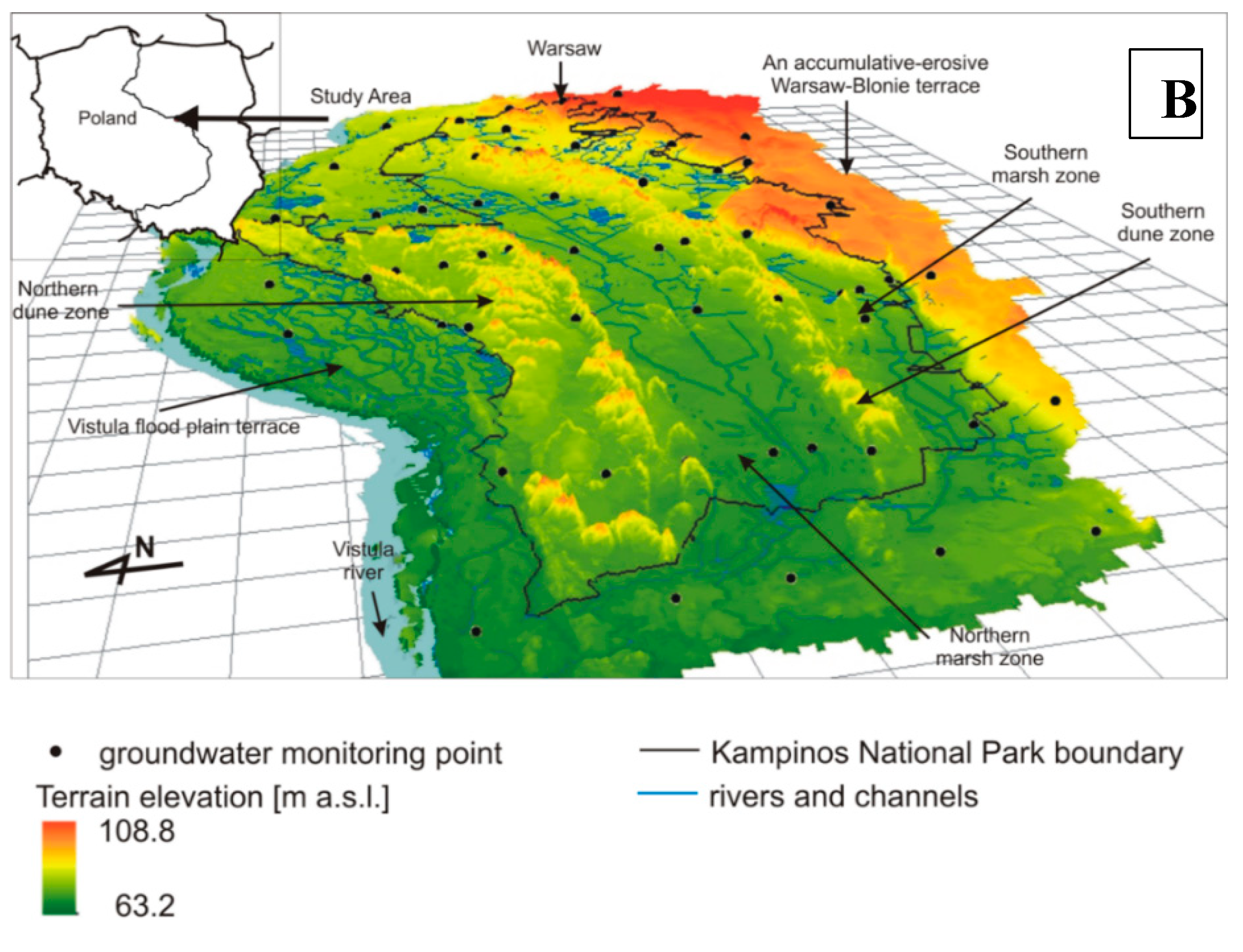

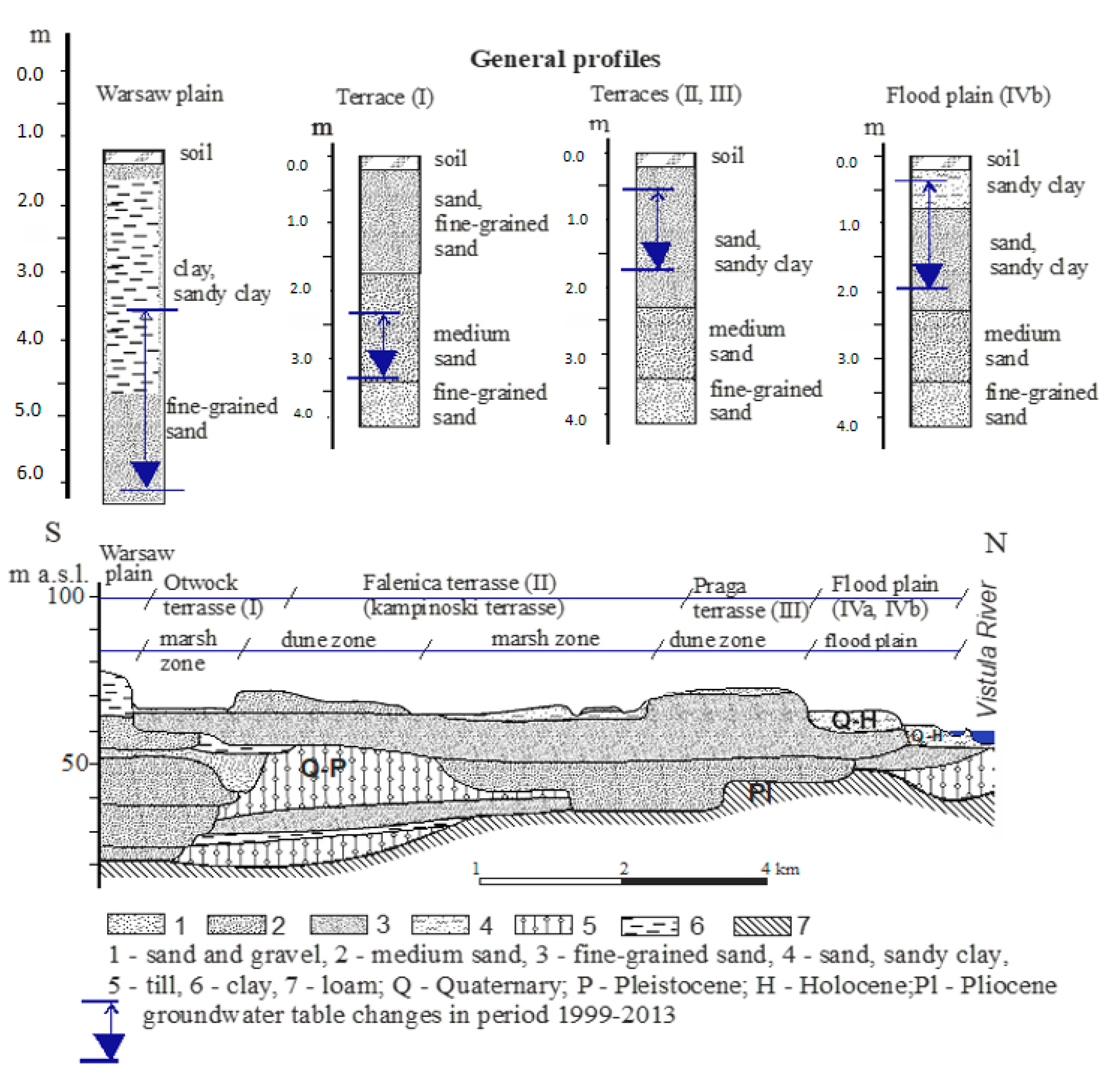
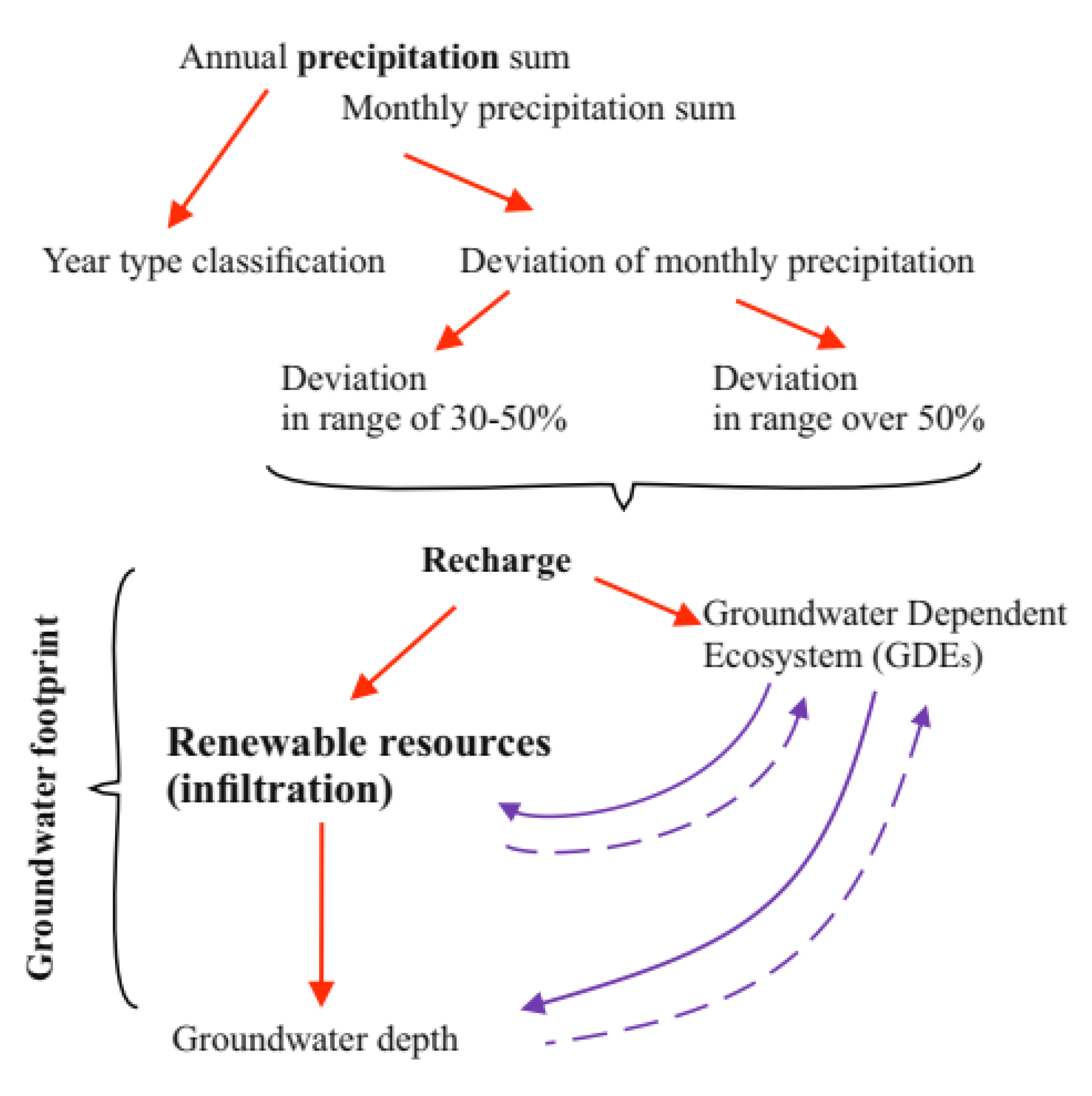
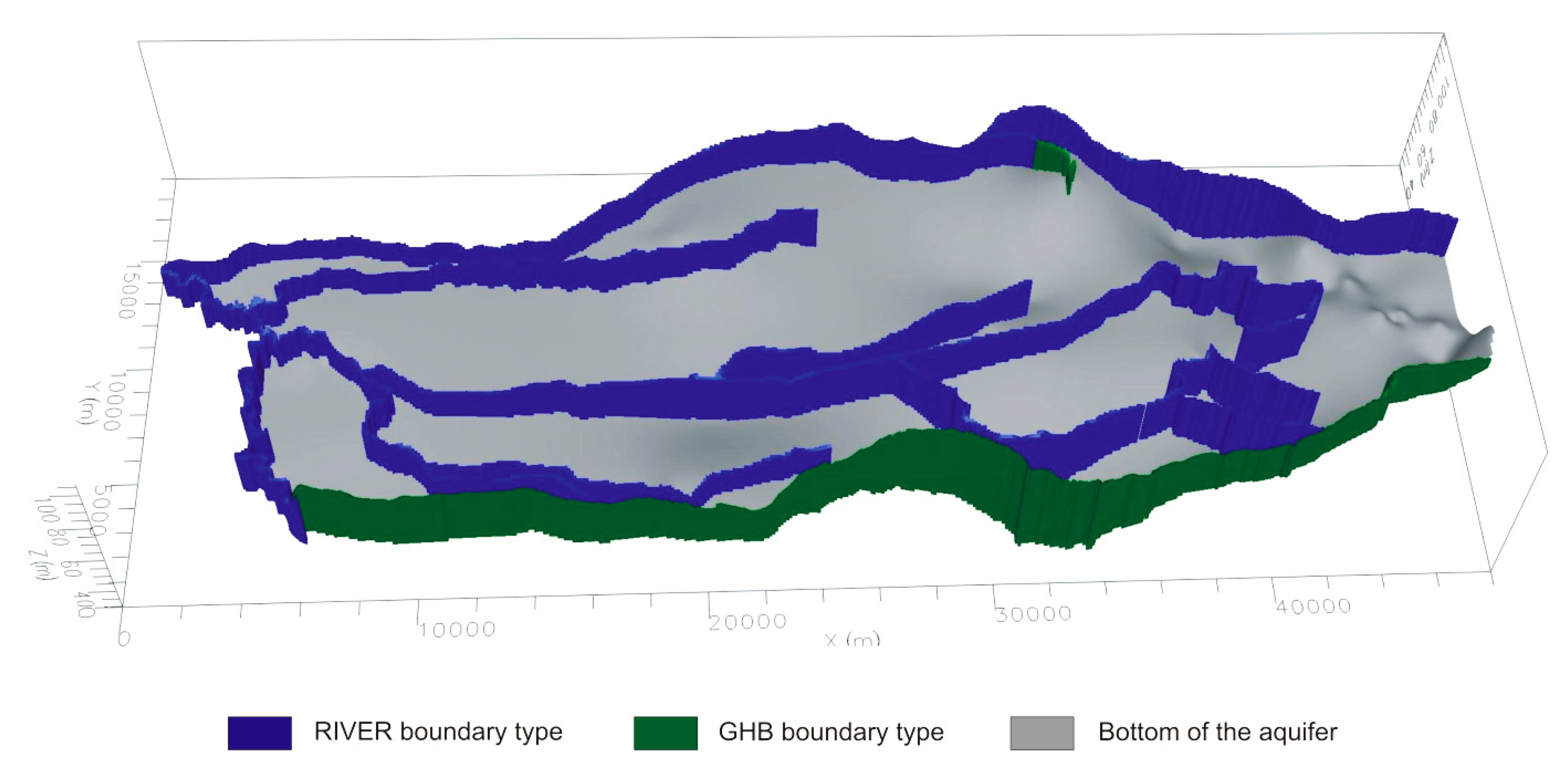

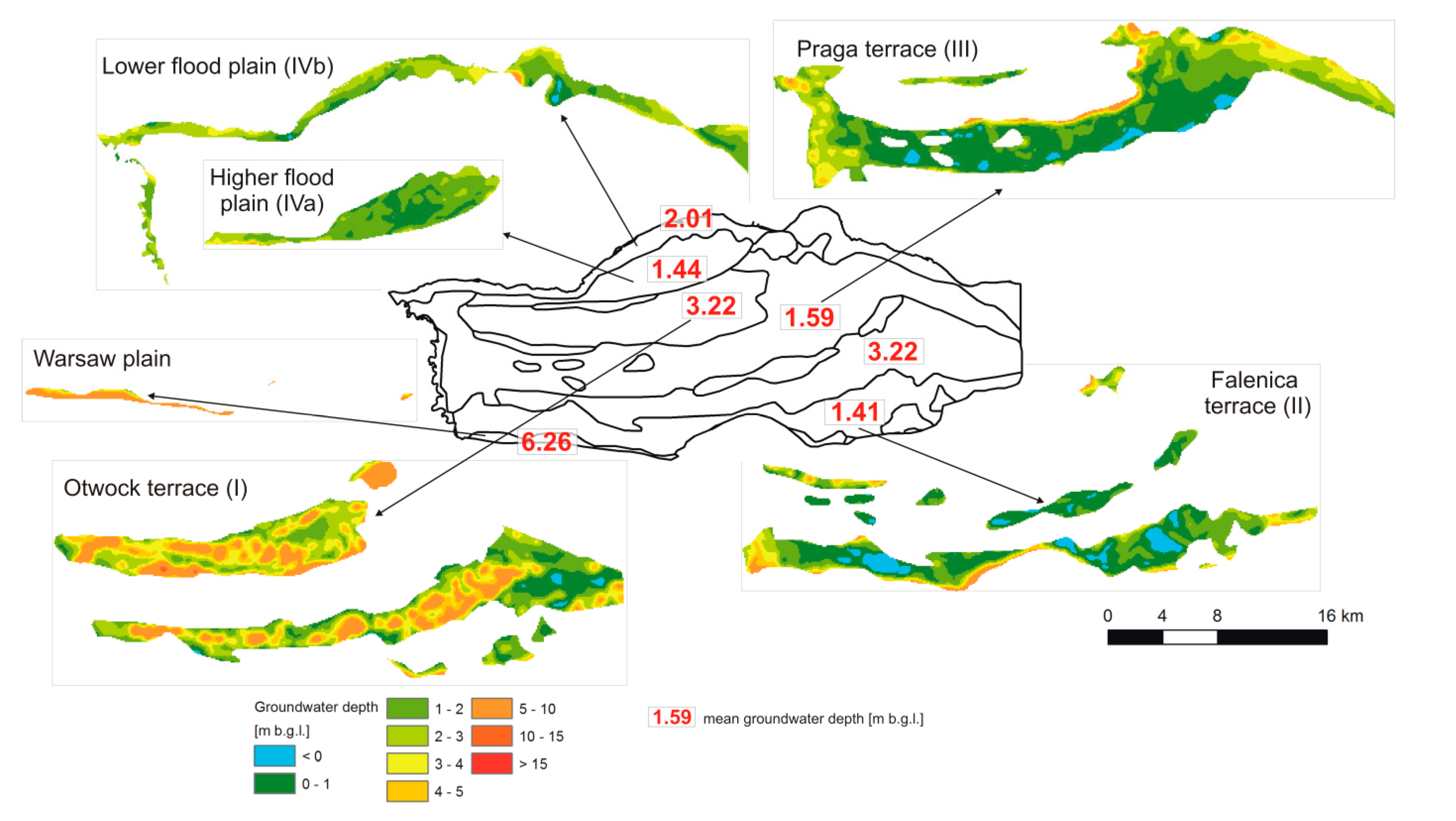
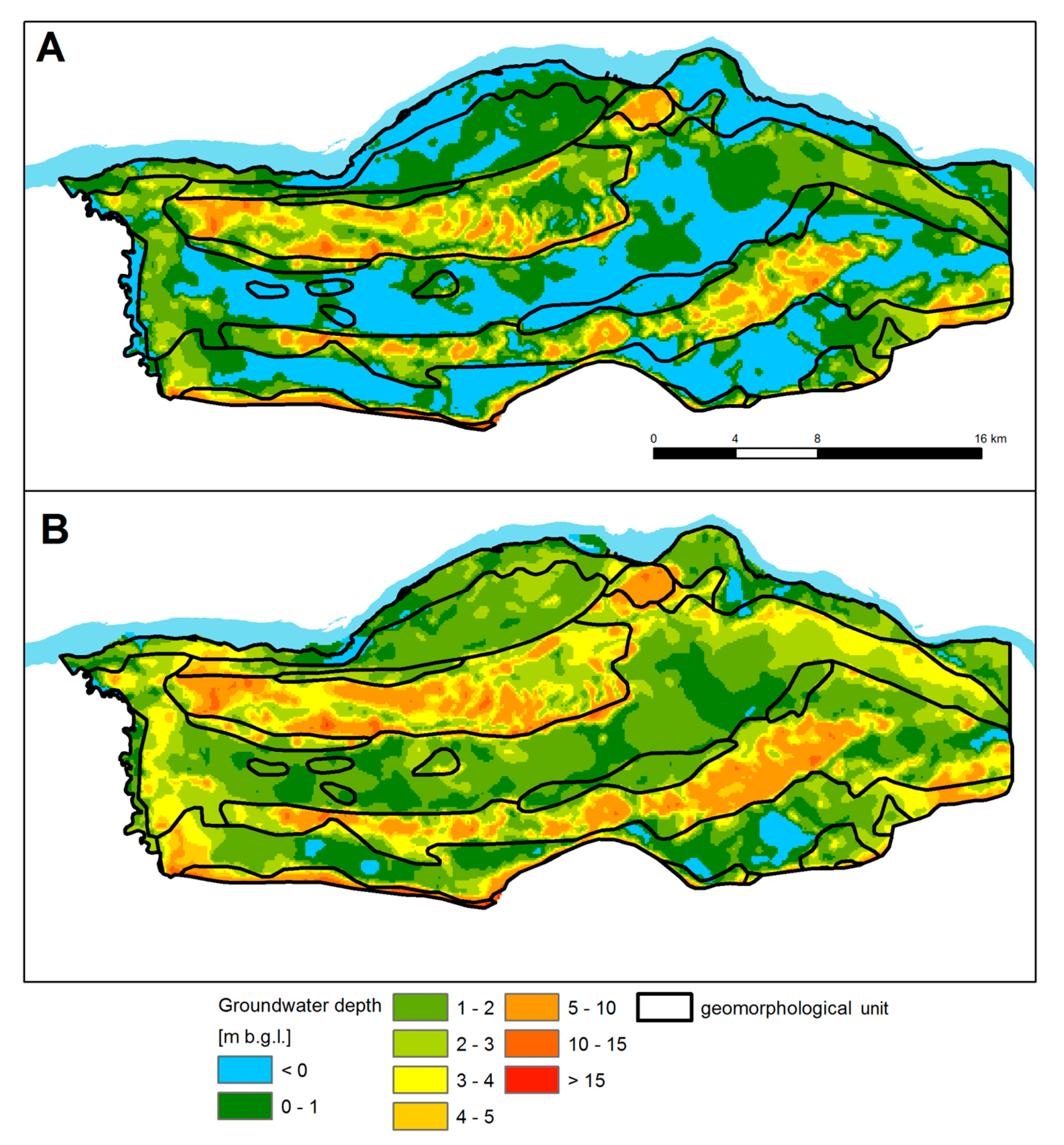
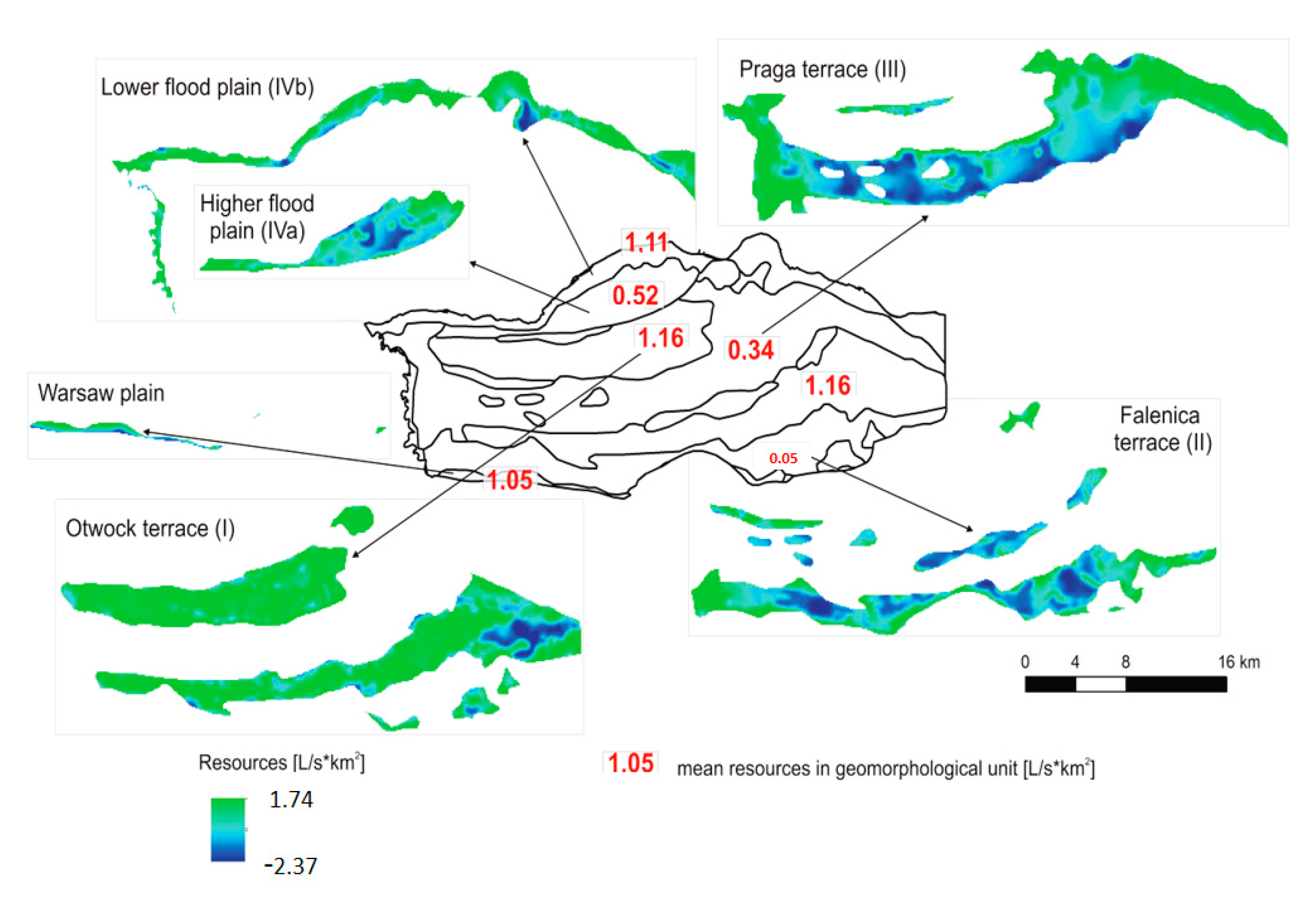
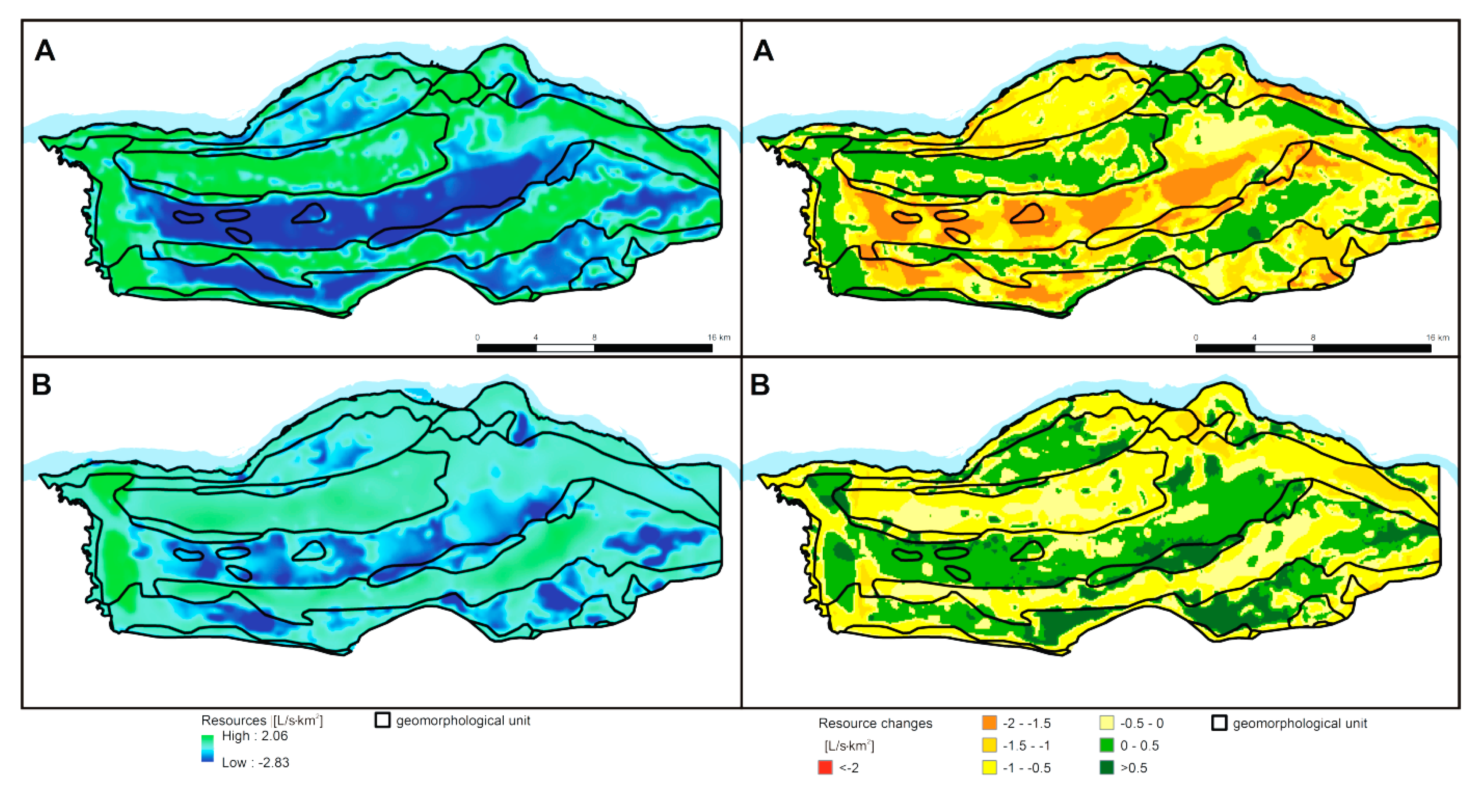
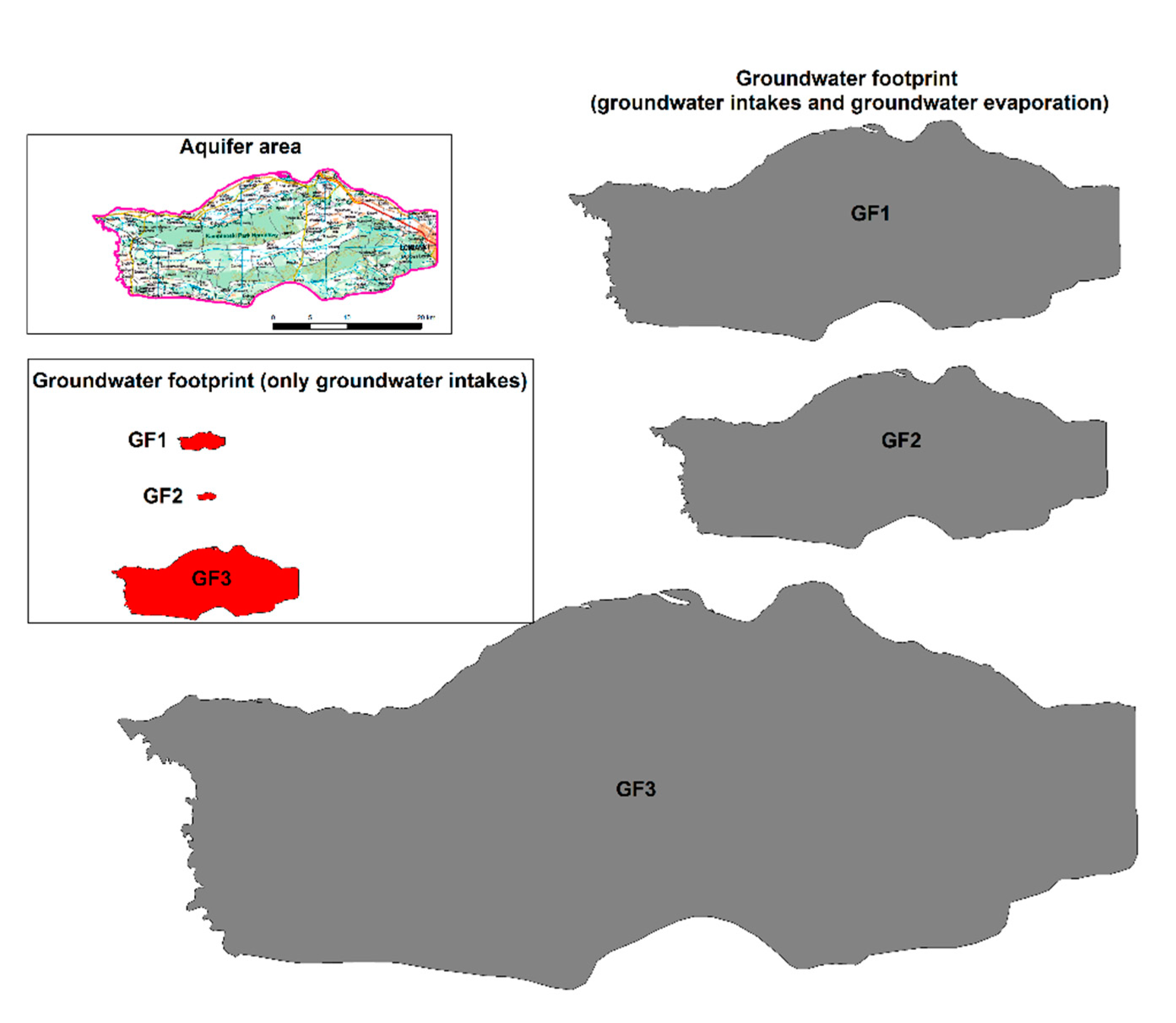
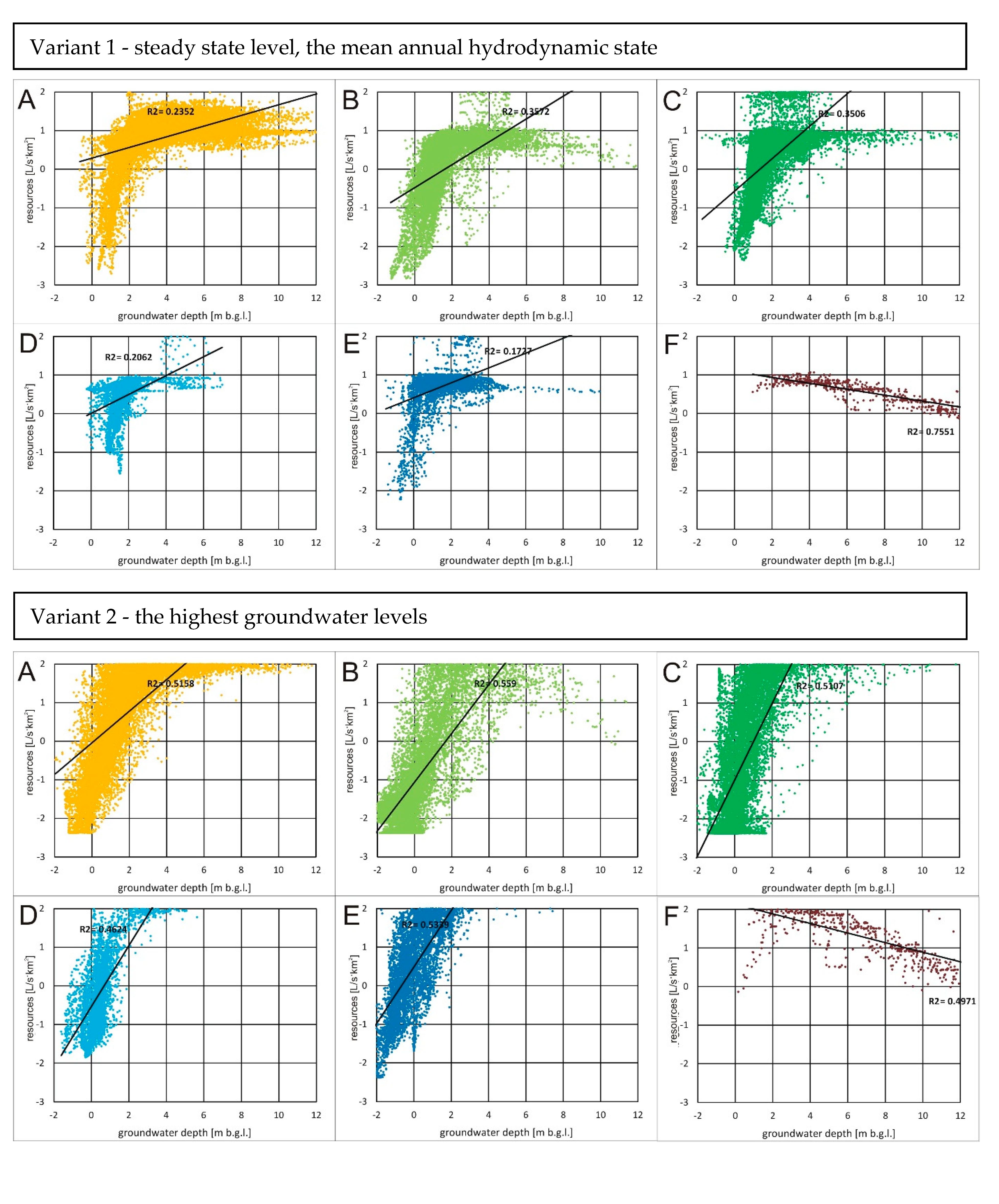

| Year | 1999 | 2000 | 2001 | 2002 | 2003 | 2004 | 2005 | 2006 | 2007 | 2008 | 2009 | 2010 | 2011 | 2012 | 2013 |
|---|---|---|---|---|---|---|---|---|---|---|---|---|---|---|---|
| Type of year in the reference to average precipitation | average | very dry | wet | average | dry | average | Dry | wet | wet | average | average | very wet | average | very dry | average |
| Month | Deviation of monthly precipitation D = (monthly precipitation · 100/average monthly precipitation) − 100 | ||||||||||||||
| November | −17 | 26 | 31 | −27 | −8 | −32 | 36 | −15 | 12 | −11 | −12 | 47 | 118 | −98 | −48 |
| December | 0 | −36 | 21 | −1 | −69 | 53 | −47 | 183 | −19 | −51 | 9 | 16 | −14 | −14 | −31 |
| January | −49 | −9 | −52 | 5 | 13 | −4 | −3 | −19 | 133 | 77 | −16 | −46 | −25 | −4 | −1 |
| February | 26 | −43 | −41 | 126 | −65 | 73 | 19 | 41 | 16 | −12 | −19 | −27 | −51 | −27 | −15 |
| March | −35 | 70 | −4 | 46 | −57 | 12 | 58 | −49 | 25 | 98 | 2 | −23 | −86 | −28 | −28 |
| April | 133 | −89 | 94 | −59 | −15 | 52 | −45 | 31 | −51 | −6 | −13 | −25 | −32 | 25 | 0 |
| May | −9 | −58 | −19 | −19 | 13 | −15 | 14 | −25 | 5 | −29 | −14 | 114 | −5 | −34 | 81 |
| June | 154 | −88 | 15 | −10 | −29 | −3 | 2 | −39 | 19 | −58 | −5 | 14 | −36 | 7 | 57 |
| July | −44 | 69 | 57 | −49 | −2 | −15 | −9 | −85 | −5 | 6 | −8 | 7 | 171 | −21 | −72 |
| August | −66 | −26 | −49 | 27 | −29 | −15 | −56 | 182 | 28 | 9 | −12 | 93 | −21 | −50 | −14 |
| September | −23 | −49 | 102 | −17 | 6 | −44 | −31 | −41 | 22 | 23 | 21 | 57 | −89 | −33 | 97 |
| October | 55 | −81 | −10 | 112 | 112 | 24 | −72 | 0 | 30 | −15 | 2 | −78 | −85 | 45 | −38 |
| Deviation of monthly precipitation over 50% | 4 | 5 | 4 | 3 | 4 | 3 | 3 | 3 | 2 | 4 | 0 | 4 | 6 | 2 | 4 |
| Deviation of monthly precipitation in a range 30–50% | 3 | 4 | 3 | 2 | 0 | 2 | 4 | 5 | 1 | 1 | 0 | 2 | 2 | 3 | 3 |
| Average annual GD | 1.72 | 1.97 | 2.04 | 1.90 | 2.12 | 1.98 | 2.04 | 2.02 | 1.85 | 1.94 | 2.01 | 1.65 | 1.34 | 1.66 | 1.86 |
| Statistics | Modelled Variants | ||
|---|---|---|---|
| Variant 1 | Variant 2 | Variant 3 | |
| Max. residual [m] | −0.359 | 0.692 | −0.715 |
| Min. residual [m] | 0.0600 | 0.000 | 0.000 |
| Abs. residual mean [m] | 0.128 | 0.245 | 0.209 |
| Standard error of the estimate [m] | 0.023 | 0.044 | 0.035 |
| Root mean squared [m] | 0.158 | 0.308 | 0.258 |
| Normalized RMS [%] | 0.953 | 1.849 | 1.501 |
| Correlation coefficient | 0.999 | 0.997 | 0.998 |
| Geomorphological Unit | Groundwater Depth in Model Variant–Average Value | ||
|---|---|---|---|
| Variant 1 (Figure 7) | Variant 2 (Figure 8) | Variant 3 (Figure 8) | |
| Lower flood plain (IVb) | 2.01 | 0.00 | 1.47 |
| Higher flood plain (IVa) | 1.44 | 0.43 | 1.80 |
| Praga Terrace (III) | 1.59 | 0.56 | 1.98 |
| Falenica Terrace (II) | 1.41 | 0.53 | 1.96 |
| Otwock Terrace (I) | 3.22 | 2.42 | 3.85 |
| Warsaw plain | 6.26 | 6.66 | 7.49 |
| Average value | 2.15 | 1.16 | 2.58 |
| Variant 1 (Figure 9) | Geomorphological Unit | Renewable Resources [L/s km2] | Area [km2] | |||
| Min | Mean | Max | Standard Deviation | |||
| Lower flood plain (IVb) | –2.01 | 1.11 | 1.74 | 0.81 | 59.20 | |
| Higher flood plain (IVa) | –1.61 | 0.52 | 1.74 | 0.80 | 39.00 | |
| Praga Terrace (III) | –2.17 | 0.34 | 1.74 | 1.18 | 171.03 | |
| Falenica Terrace (II) | –2.37 | 0.05 | 1.74 | 1.19 | 108.88 | |
| Otwock Terrace (I) | –2.37 | 1.16 | 1.74 | 0.90 | 185.07 | |
| Warsaw plain | –0.31 | 1.05 | 1.74 | 0.57 | 6.54 | |
| Average value: | 0.65 | sum: | 569.72 | |||
| Variant 2 (Figure 10) | Geomorphological Unit | Renewable Resources [L/s km2] | Area [km2] | |||
| Min | Mean | Max | Standard Deviation | |||
| Lower flood plain (IVb) | –2.37 | 0.47 | 2.06 | 1.12 | 59.20 | |
| Higher flood plain (IVa) | –1.85 | –0.21 | 2.06 | 0.96 | 39.00 | |
| Praga Terrace (III) | –2.37 | –0.45 | 2.06 | 1.73 | 171.03 | |
| Falenica Terrace (II) | –2.37 | –0.73 | 2.06 | 1.45 | 108.88 | |
| Otwock Terrace (I) | –2.37 | 0.94 | 2.06 | 1.26 | 185.07 | |
| Warsaw plain | –0.29 | 1.30 | 2.06 | 0.64 | 6.54 | |
| Average value: | 0.08 | sum: | 569.72 | |||
| Variant 3 (Figure 10) | Geomorphological Unit | Renewable Resources [L/s km2] | Area [km2] | |||
| Min | Mean | Max | Standard Deviation | |||
| Lower flood plain (IVb) | –2.22 | 0.68 | 2.06 | 0.49 | 59.2 | |
| Higher flood plain (IVa) | –1.55 | 0.44 | 2.04 | 0.50 | 39 | |
| Praga Terrace (III) | –2.36 | 0.25 | 2.04 | 0.87 | 171.03 | |
| Falenica Terrace (II) | –2.83 | 0.09 | 2.06 | 0.85 | 108.88 | |
| Otwock Terrace (I) | –2.70 | 0.81 | 2.06 | 0.64 | 185.07 | |
| Warsaw plain | –0.23 | 0.51 | 1.06 | 0.32 | 6.54 | |
| Average value: | 0.46 | sum: | 569.72 | |||
| Data | Symbol | Variant 1 | Variant 2 | Variant 3 | |
|---|---|---|---|---|---|
| (1999–2013) | (Year 2011) | (Year 2003) | |||
| Area [km2] | Remarks | A | 581.8 | 581.8 | 581.8 |
| Groundwater intakes [m3/d] | C | 4779.7 | 4779.7 | 4779.7 | |
| Recharge [m3/d] | Modelling research in 3 variants | R | 79622.9 | 118841.3 | 45362.28 |
| Run off [m3/d] | Modelling research in 3 variants | E | 45028.3 | 24583.4 | 36559.64 |
| Groundwater evaporation [m3/d] | Modelling research in 3 variants | GE | 50629 | 104492.4 | 21278.72 |
| Groundwater footprint | only groundwater intakes | GF | GF1 = 80.38 | GF2 = 29.50 | GF3 = 315.91 |
| [km2] | |||||
| Groundwater footprint | groundwater intakes and groundwater evaporation | GF | GF1 = 931.84 | GF2 = 674.47 | GF3 = 1722.30 |
| [km2] – Figure 11 | |||||
| Groundwater stress | only groundwater intakes | GF/A | 0.14 | 0.05 | 0.54 |
| Groundwater stress | groundwater intakes and groundwater evaporation | GF/A | 1.6 | 1.16 | 2.96 |
© 2020 by the authors. Licensee MDPI, Basel, Switzerland. This article is an open access article distributed under the terms and conditions of the Creative Commons Attribution (CC BY) license (http://creativecommons.org/licenses/by/4.0/).
Share and Cite
Krogulec, E.; Zabłocki, S.; Sawicka, K. Temporal and Spatial Diversity of Renewable Groundwater Resources in the River Valley. Appl. Sci. 2020, 10, 4827. https://doi.org/10.3390/app10144827
Krogulec E, Zabłocki S, Sawicka K. Temporal and Spatial Diversity of Renewable Groundwater Resources in the River Valley. Applied Sciences. 2020; 10(14):4827. https://doi.org/10.3390/app10144827
Chicago/Turabian StyleKrogulec, Ewa, Sebastian Zabłocki, and Katarzyna Sawicka. 2020. "Temporal and Spatial Diversity of Renewable Groundwater Resources in the River Valley" Applied Sciences 10, no. 14: 4827. https://doi.org/10.3390/app10144827
APA StyleKrogulec, E., Zabłocki, S., & Sawicka, K. (2020). Temporal and Spatial Diversity of Renewable Groundwater Resources in the River Valley. Applied Sciences, 10(14), 4827. https://doi.org/10.3390/app10144827





